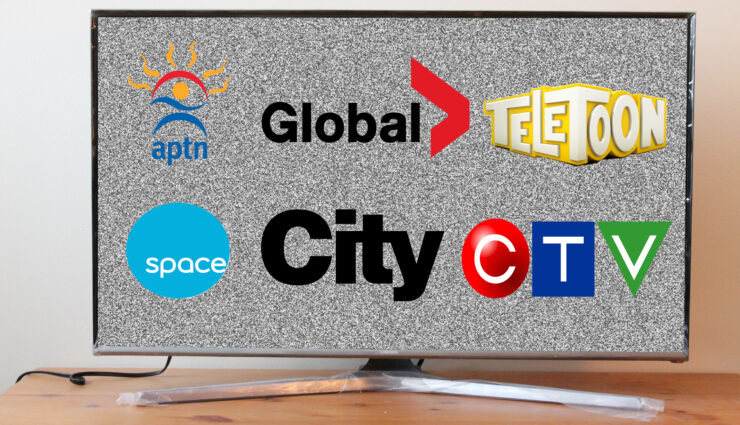The dysfunctional state of Canada’s television industry
Like most shy kids without any real, close friends, television used to be one of my only sources of companionship growing up.
And, believe it or not, a big chunk of the TV programs that kept me entertained and educated in those days were Canadian. So much so that I could plan my entire day around these homegrown productions.
Mornings were reserved for my science and science-fiction fix, which was satisfied by the likes of Popular Mechanics for Kids (Global) and Beast Wars (YTV) respectively.
Afternoons called for more of a zany touch, a need that was quickly answered by comedy staples such as Corner Gas (CTV) and re-runs of The Kids in the Hall (The Comedy Network).
And when my parents weren’t watching me like a hawk in the evenings, I’d indulge in some bad language and general debauchery on the boob tube thanks to Trailer Park Boys and Kenny vs. Spenny (Showcase).
Heck, if I stayed up late enough, I usually got to see some nudity on that same channel—does anybody else remember Webdreams?
Unfortunately, this kind of daring, boundary pushing content has been virtually erased from today’s Canadian television landscape. Outside of the CBC’s lineup, what passes for original content these days is pretty suspect and mostly involves re-branding popular American reality TV with the word “Canada” at the end of it (think The Amazing Race, Master Chef, Big Brother etc.).
And this creative wasteland is potentially going to get worse in 2016. Starting in March, the Canadian Radio-television and Telecommunications Commission (CRTC) is going to force our country’s cable providers to offer their customers a bare bones “skinny package”, a move that threatens to eliminate specialty channels that have been supported by the bundling system for years.
So, what does this mean for the modern Canadian television landscape and, more importantly, what is it going to look like ten years from now?
Jumping Ship
Of course, one of the reasons why the industry looks so different today is that its viewers have been abandoning it by the thousands.
According to Boon Dog Professional Services—a local research and consulting firm—cable and satellite providers such as Bell, Rogers, Shaw, and Telus lost a record 153,000 subscribers in Canada by the third quarter of 2015, a rate that’s increased seven fold from the previous year.
Boon Dog’s co-founder Mario Mota believes that this number of lost subscribers could easily surpass 200,000 when the remainder of the year is taken into account.
“There’s a lot more choices for people to consume TV content,” said Mota, when asked why people are leaving their cable subscriptions in droves. “With streaming media services like Netflix, and now we have in Canada Shomi and Crave TV, there are lots of ways to consume content beyond just streaming and the traditional TV system.”
This growing demographic—dubbed “cord-cutters”—is becoming so prevalent in the market that some have even made a living based on catering to their entertainment needs specifically.
Sean Whitehead definitely had this market in mind when he founded Kutko Canada in 2013, a Toronto-based media concierge service that is designed to help viewers make the transition from traditional TV to Internet streaming services.
“For the most part, a lot of people really, really do not have good experiences with the cable companies,” said Whitehead, claiming that these organizations are completely out of touch in terms of what the public wants, especially when it comes to factors like convenience and choice.
“When you’re locked into a cable deal, you’re paying the same amount for 12 months of the year, but you’re not necessarily consuming the same amount of content for those 12 months because most of the channels that you watch are re-broadcasting a lot of (the same) stuff.”
Whitehead goes on to explain that this outdated mentality extends beyond customer service and is embedded into the core of their business model.
“If you buy a Roku or an Apple TV in Canada and you set it up as a Canadian version, there is not one Canadian media app on those platforms, still. And the Apple TV has been around in Canada for almost seven years.”
“So there’s no Global app, no City TV app… any of the major media companies, they have not moved onto these platforms, and these are the same companies that say that they are starved for more eyeballs and more advertising revenue.”
This need for cable companies to update their business models is especially dire, based on the fact that “cord-nevers”—the name given to viewers who have never subscribed to any form of cable or satellite packages—are even more prevalent than the cord cutters that Whitehead services.
Groups like Forrester Research even predict that this demographic will accumulate 35 per cent of the TV-watching audience (aged 18 to 31) by 2025.
“These are people who have grown up with smart phones, tablets, computers, and have taken to the digital platforms very easily and, as a result, that’s one of the things that the cable companies… are most worried about.”
Suffice it to say, if Canadian cable providers and the CRTC can’t adapt to these changes in demographics and technology, there likely isn’t going to be any meaningful platform for them to showcase genuine Canadian art in the future.
Genre Dilution
An outdated business model and increasingly shrinking audience isn’t the only unsavoury part of the Canadian television industry in 2016.
Once these new CRTC regulations are put in place, specialty channels will no longer be protected by the bundling system and must be selected on a pick-and-pay basis instead.
As Mota points out, this is concerning since the vast majority of the most challenging and critically acclaimed programming from the United States doesn’t originate from the network television stations that are available through any basic cable package (ABC, NBC, CBS, Fox).
“Usually it’s the cable networks and the specialty channels and the premier paid channels that tend to take a greater amount of risk,” he said, echoing networks such as HBO, Showtime, FX, and AMC, whose smaller subscriber base allows them a little more leeway in terms of favouring quality over ratings.
Mota uses the AMC period drama Mad Men to illustrate his point, stating that such a project wouldn’t have survived in the network system, despite its critical acclaim, prominent online buzz, and a loyal water cooler following.
“It may never have been made and it may never have gone beyond one or two seasons, just because the larger networks need to have the larger audiences,” he said, reflecting on how the ratings for this drama’s series finale in May of 2015 still can’t hold a candle to network reruns of NCIS: Los Angeles.
Unfortunately, in the wake of the CRTC’s plans to unbundle certain channels and eliminate genre protection, safe and predictable network television on Global, CTV, and City might be the only options we have left.
Over the last couple years, specialty channels like Showcase and Much (no longer being known as MuchMusic) have been gutted of their original, genre-specific content, and their programming has been replaced with hit American shows or reruns from their past glory days.
Greg O’Brien—an editor for the Canadian television news website Cartt.ca—states that perhaps the worst example of this trend is Book Television, whose programming line-up no longer consists of distinct literary properties.
“If you want to binge watch the 70s sitcom One Day at a Time, you can sit in front of Book TV and watch it all night long. I think it airs from 12 to 6 a.m. non-stop every day.”
Still, despite the fact that this channel doesn’t have any real employees or new genre-specific content to offer, O’Brien reveals that it will be kept alive in its current state as long as it still makes money.
“Bell is not going to actively kill it off because why would you kill off $4.8 million a year in revenue? That’s how much that channel makes and I remember it because that’s the channel that everyone holds up as ‘Here’s what’s wrong with the system.’”
“So they’re just going to continue to cash the cheque for this channel until it peters out to zero.”
With such an emphasis on empty profit instead of quality content, O’Brien remains skeptical that anything remotely edgy or boundary pushing could even make it to the development stage in this current climate.
“There’s a whole bunch of different places where money is going in to make shows, but Kids in the Hall, yeah, I’m not sure that a variety show like that would get made again.”
CANCON Quota
But if our country’s genre-specific programs can’t get off the ground, what does that mean for content that’s supposed to represent our national identity?
Of course, the CRTC already has Canadian content (or CanCon) requirements in place, although some of those parameters have been severely loosened for every time slot except prime time.
However, Whitehead believes that cable companies are following these CanCon rules just to fill a quota.
“I personally find that the Canadian cable companies hide behind the CanCon rules,” he said, stating that advertising dollars mostly go towards producing Canadianized versions of American reality TV, which is evident when you realize that they are the only Canadians programs that are guaranteed to crack one million viewers.
“If you look at any kind of advertising push by any of the major networks owned by the Canadian media companies, they’re not pushing Canadian content. They’re pushing the American shows that they license. So, I mean, they are doing the minimal amount of work to contribute to the Canadian identity.”
Some might suggest that this situation could be remedied by committing to a different distribution system, since Canadian classics like Trailer Park Boys and Degrassi have found a second life after being picked up by Netflix.
But O’Brien believes that it isn’t that easy, especially when the Canadian Media Fund is one of the only ways that projects can get off the ground.
“Approximately five per cent of everybody’s cable bill flows into that fund, or some other fund so that they can spend it on… making Canadian content. So if fewer and fewer people pay for cable, or if they start paying less for cable, that amount of money in that fund is going to drop and that will cause less Canadian content to get made.”
And even though Rogers, Shaw, and Bell are breaking ground with new streaming services like Shomi and Crave TV, they still have an uphill battle to contend with Netflix as the dominant nation-wide streaming service, which doesn’t bode well for the development of new intellectual properties.
“Because Netflix, they don’t employ anybody here in Canada, at all. They do buy Canadian shows, so some money will flow to the producers of Trailer Park Boys, or some of the other Canadian shows that they have… but as far as brand new TV shows, or future TV shows, there’s going to be less money available for that because people are opting out of the system.”
Growing Pains
While there’s a variety of unique theories about how this dysfunctional period in Canadian television will play itself out, critics aren’t sure about what the future will hold.
Mota remains more optimistic about the prospect of Canadian show runners pumping out “some pretty popular original shows” while garnering “some pretty good critical acclaim and audience following,” which isn’t totally out of the question now that homegrown entertainments like Orphan Black, Vikings, and Michael: Tuesdays and Thursdays will be returning to Canadian airwaves this year.
True to the nature of his business, Whitehead believes that the future of Canadian TV lies exclusively in online distribution, claiming that many of his clients have even said that “they would pay $5 to $8 a month if there was a CBC service like Netflix that allows them to access all of CBC’s shows.”
O’Brien takes more of a global-minded approach, stating that “the media world in general, it’s all becoming one big global mishmash,” a sentiment that will hopefully bear fruit once the internationally focused, Canadian-produced channel Viceland launches on Feb. 29.
https://www.youtube.com/watch?v=4pCNJKGhQXM
As for me, I just want the industry to resolve these technological, logistical, and artistic growing pains soon, in the hopes that some other little Canadian kid growing up can organize his entire day around native televised content.
But hopefully the solution they come up with isn’t producing a dark, gritty reboot of The Littlest Hobo. That would suck.





